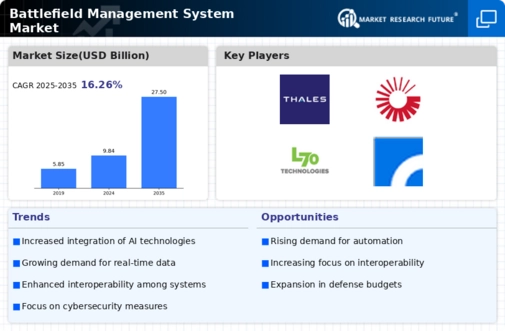Top Industry Leaders in the Battlefield Management System Market

Key Companies in the battlefield management system market include.
Collins Aerospace (US)
Rolta India Limited (India)
Cobham PLC (UK)
General Dynamics Corporation (US)
L3 Technologies Inc. (US)
Lockheed Martin Corporation (US)
Elbit Systems Ltd (Israel)
Leonardo SpA (Italy)
Thales Group (France)
Atos SE (France)
BAE Systems PLC (UK)
Northrop Grumman Corporation (US)
Raytheon Company (US)
Saab AB (Sweden)
Harris Corporation (US)
Strategies Adopted
Industry news within the Battlefield Management System market reflects ongoing trends, geopolitical considerations, and the sector's response to the evolving requirements of defense organizations globally. News related to successful BMS deployments, collaborations with military forces, and advancements in data integration technologies showcase efforts to enhance system performance and operational capabilities. Moreover, developments in BMS applications, such as the integration of wearable devices for dismounted soldiers and the incorporation of augmented reality for enhanced situational awareness, are frequently covered in industry news, reflecting the industry's commitment to staying at the forefront of battlefield technology.
Current investment trends in the BMS industry underscore a dual focus on research and development and strategic partnerships. Key players are directing investments towards improving BMS system effectiveness, exploring new applications for data analytics, and collaborating with defense agencies for system integration. Investments in digital infrastructure, cybersecurity measures, and compliance with stringent military standards are prevalent, reflecting the industry's adaptation to the growing emphasis on data security and operational resilience. Additionally, strategic investments in acquisitions and partnerships aim to strengthen market presence and enhance the overall capabilities of Battlefield Management System providers.
Emerging Companies
The overall competitive scenario in the Battlefield Management System market is characterized by established brands and dynamic newcomers, each navigating the industry with distinct strategies. Market share analysis considers factors such as BMS system effectiveness, interoperability with existing military platforms, and adaptability to different operational scenarios. The industry's responsiveness to technological advancements, geopolitical shifts, and the integration of artificial intelligence further shapes competitiveness. As defense organizations worldwide seek advanced and adaptable BMS solutions to meet evolving security challenges, the market is poised for continued growth. Companies in this sector are striving to balance innovation, quality, and affordability to maintain a competitive edge in a complex and rapidly evolving defense technology landscape.
Recent News
Lockheed Martin (USA):
Integrated Fire Control Network (IFCN) Development: Lockheed Martin continues developing the IFCN, a next-generation BMS for the U.S. Army, aiming to provide seamless battlefield information sharing and coordinated operations across various units and assets. Recent achievements include successful integration with air and ground platforms and live-fire exercises demonstrating enhanced situational awareness and decision-making.
Focus on Interoperability: Lockheed Martin prioritizes interoperability with existing and future NATO systems, ensuring seamless information exchange and collaboration with allied forces.
Raytheon Technologies (USA):
Command and Control On the Move (C2OTM) Upgrades: Raytheon is upgrading its C2OTM system for the U.S. Marine Corps, improving its mobility, ruggedness, and communication capabilities for enhanced command and control on the battlefield. Testing with troops at simulated forward operating bases showcases the system's effectiveness in challenging environments.
Focus on Commercial Technologies: Raytheon incorporates commercially available technologies into their BMS solutions, leveraging advancements in cyber security, cloud computing, and artificial intelligence for improved performance and affordability.
Elbit Systems (Israel):
Dominator BMS Expansion: Elbit Systems continues expanding its Dominator BMS user base, securing new contracts with European and Asian countries. Its modular design and scalability cater to diverse military needs and budgets.
Emphasis on Tactical Edge Computing: Elbit integrates tactical edge computing technologies into its BMS, enabling faster data processing and decision-making at the operational edge, closer to the frontline troops.
Saab AB (Sweden):
Tactiacal Information Management System (TIMS) Updates: Saab continues upgrading its TIMS BMS for the Swedish Armed Forces, focusing on enhanced cyber security, integration with unmanned aerial vehicles (UAVs), and improved user interfaces. Recent exercises demonstrate the system's effectiveness in coordinating drones with ground forces for real-time reconnaissance and precision targeting.
Open Architecture Approach: Saab prioritizes an open architecture approach in its BMS development, allowing for easier integration with third-party systems and future technological advancements.
Thales Group (France):
Synapse BMS Modernization: Thales is involved in modernizing the French Army's Synapse BMS, integrating new features like tactical cloud capabilities and advanced intelligence analysis tools. This upgrade aims to provide French troops with a secure and reliable information network for coordinated operations.
Focus on Cybersecurity: Thales prioritizes robust cyber defense measures in its BMS solutions, safeguarding sensitive military data and ensuring secure communication channels.
Emerging Trends in Battlefield Management Systems:
Emphasis on real-time data sharing and collaborative decision-making across various military branches and assets.
Integration of artificial intelligence (AI) for battlefield analysis, predictive insights, and threat detection.
Adoption of tactical edge computing for faster data processing and decentralized decision-making at the frontline.
Focus on cyber security and robust data protection measures to counter evolving threats.
Increased interoperability with allied systems and commercial technologies for improved collaboration and cost-effectiveness.


